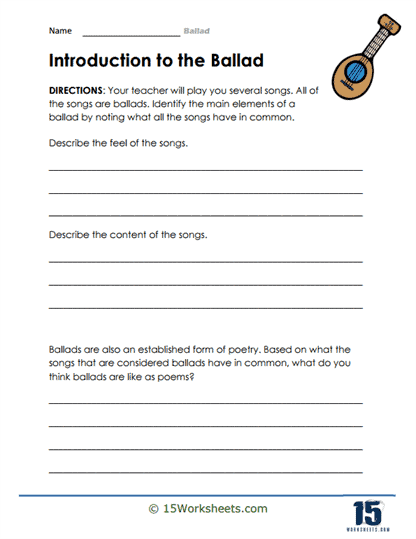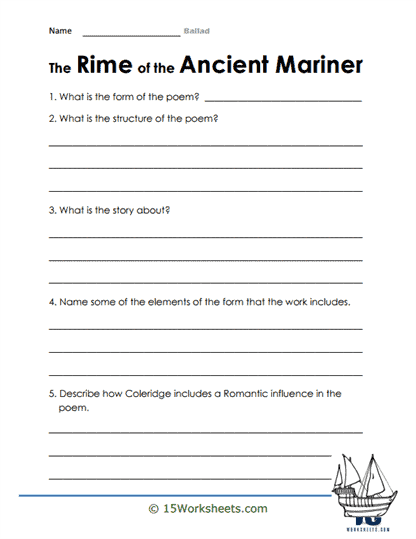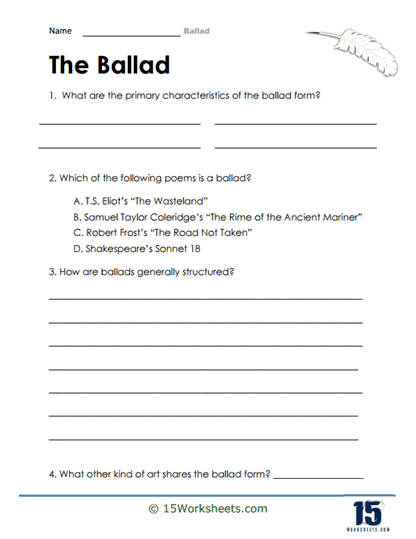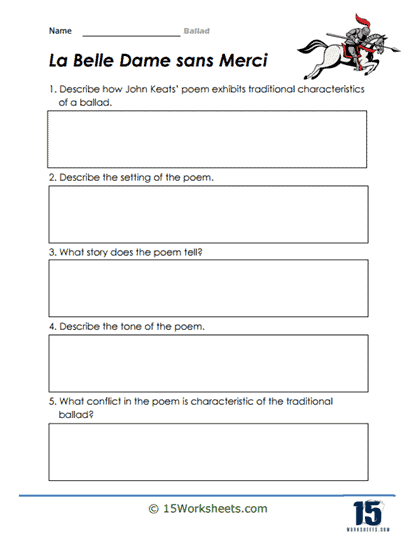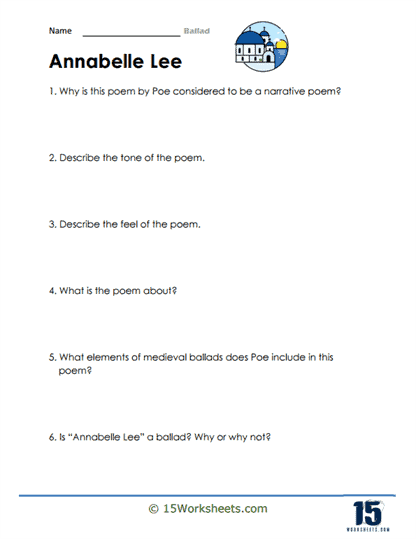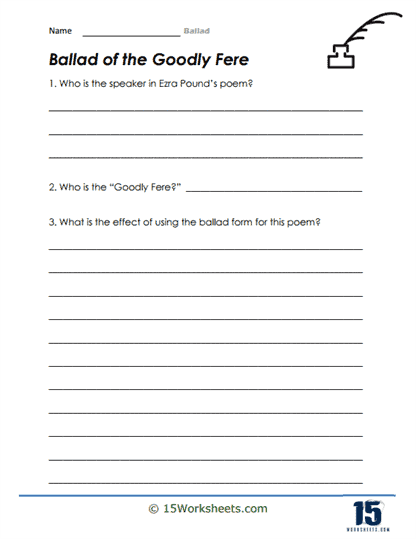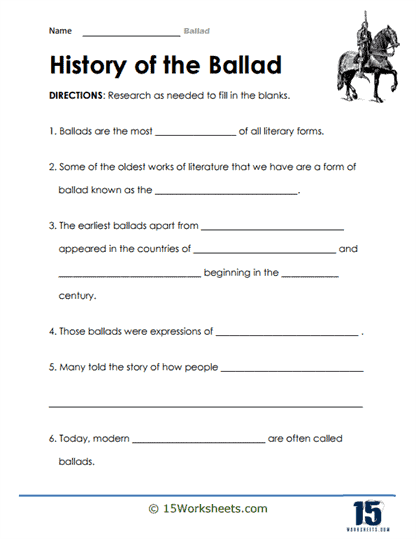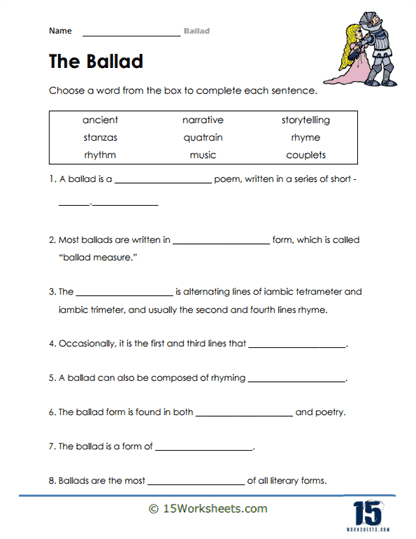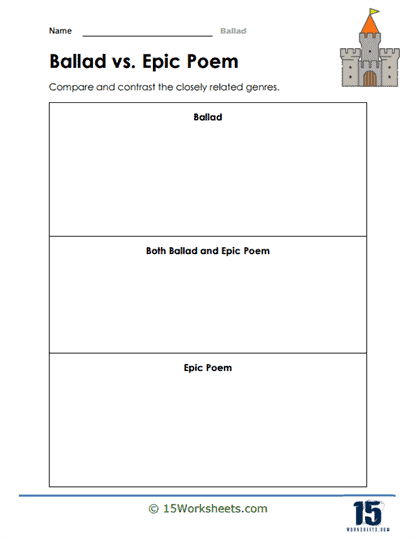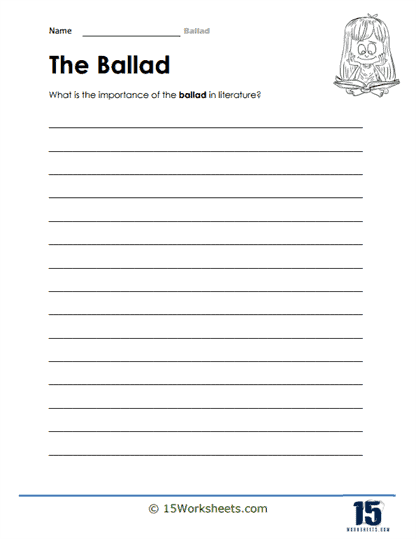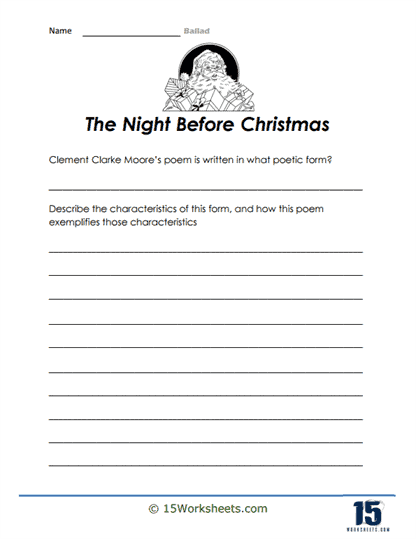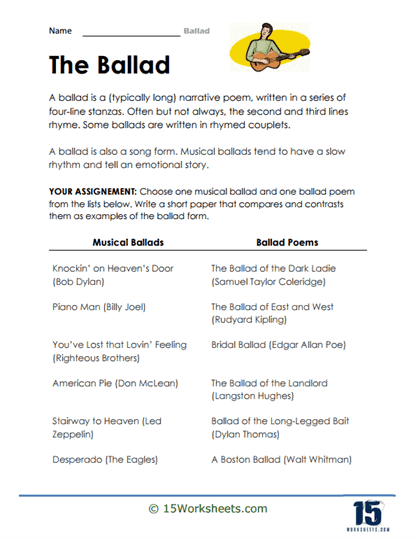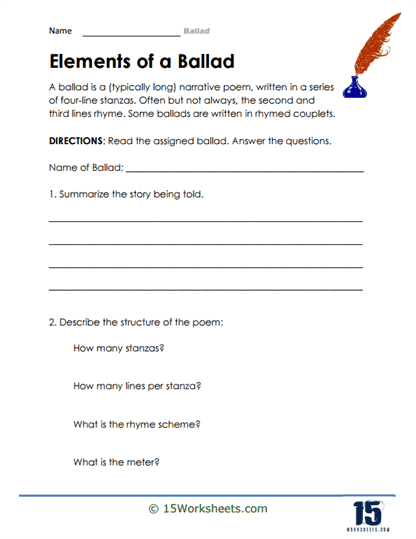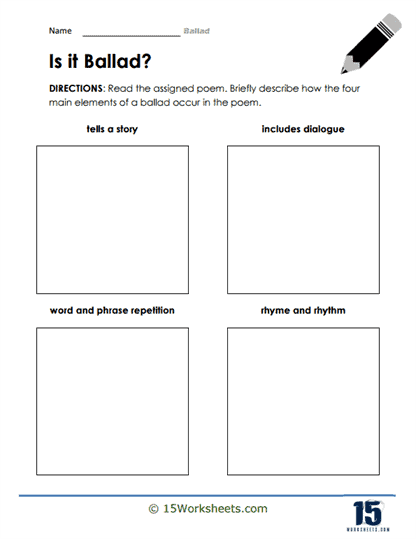Ballad Worksheets
All About These 15 Worksheets
Ballads, narrative poems that tell a story through verse, have been a timeless and captivating form of oral and written tradition for generations. Understanding and engaging with ballads not only deepens a student’s appreciation for poetry and storytelling but also enhances their literary analysis, creative writing, and cultural awareness.
In a world where effective communication, critical thinking, and the appreciation of diverse cultures are paramount, students must develop the ability to recognize, analyze, and craft ballads. To empower students with the knowledge of ballads and their rich history, we proudly present a collection of 15 worksheets. These worksheets are meticulously designed to provide students with structured and engaging opportunities to explore, practice, and master the art of balladry.
These worksheets are tailored to break down the complex elements of a ballad into simpler, more digestible pieces. They aim to enhance your understanding of how a ballad is structured, the characteristic features it possesses, and the ways authors use this literary device to tell a story.
What Is A Ballad?
A ballad, in the sphere of literary devices, can be described as a type of poetry or verse which is narrated in a song. Originating from the medieval times, ballads are used to depict a variety of topics ranging from love stories and heroic tales to legends and folklore. The ability to weave compelling narratives in a musical form makes ballads a popular choice for poets and authors to present their work in an appealing, rhythmic manner.
The primary defining feature of a ballad is its narrative structure. Ballads tell a story in a song-like fashion, which distinguishes them from other forms of poetry. They usually adopt a simple language and structure to convey their narratives vividly and memorably. With a consistent rhythm and rhyme scheme, ballads are often written in quatrains, four-line stanzas. Typically, the second and fourth lines rhyme, enhancing the musical quality of the narrative.
Characteristics Of A Ballad
Ballads possess several characteristic features. Firstly, they are narrative in nature, recounting a story that is significant or dramatic. The stories are often short and rely on imagery and emotive language to captivate readers. Secondly, they often employ repetition and refrain to emphasize key themes and to create a sense of rhythm and musicality.
Additionally, ballads use incremental repetition, where a phrase or stanza is repeated but with slight changes each time to advance the narrative. Thirdly, ballads often feature dialogue. This allows for direct interaction between characters, and can be used to enhance the drama of the narrative. Lastly, ballads often use a specific form of poetic meter, generally iambic, to maintain a steady rhythm.
Ballads are a powerful tool for authors because they create an immersive narrative experience that connects deeply with the reader’s emotions. The musical and rhythmic quality of the ballad helps to make the narrative more memorable, while the use of simple language makes the narrative accessible. These aspects, combined with the often dramatic and emotive nature of the ballads’ stories, allow authors to engage readers on an emotional level, fostering a deeper connection with the narrative.
Examples in Literature
Let’s consider three examples of ballads to better understand their application and impact:
“The Rime of the Ancient Mariner” by Samuel Taylor Coleridge – This lengthy ballad is one of the most famous in English literature. Coleridge employs the traditional structure and rhythmic pattern of the ballad to weave a haunting narrative about a mariner who brings a curse upon his ship by killing an albatross. Coleridge’s use of the ballad form allows him to combine dramatic narrative with philosophical reflection, making the story both exciting and thought-provoking.
“La Belle Dame sans Merci” by John Keats – Keats’ ballad tells a tragic story of a knight who falls in love with a mysterious woman, only to be left alone and heartbroken. Keats uses the musicality of the ballad form to emphasize the knight’s desolation and the dream-like quality of his encounter with the “belle dame.” The narrative structure and refrains of the ballad create a cyclical pattern that mirrors the knight’s ongoing despair.
“As You Came from the Holy Land” by Sir Walter Raleigh – This ballad, also known as “The Nymph’s Reply to the Shepherd,” uses the dialogue feature of ballads to create a conversation between a shepherd expressing his love and a nymph responding with realism. Raleigh’s ballad employs the musical and repetitive elements of the form to contrast the shepherd’s romantic idealism with the nymph’s practicality.
In each of these examples, the authors use the ballad form to create engaging narratives that speak to human emotions and experiences. The rhythmic and musical qualities of the ballad make the narratives memorable and compelling, while the simple language ensures that the narratives are accessible to a wide audience. The ballad, as a literary device, is a powerful tool for authors who wish to tell emotive stories in a captivating way.
The Importance Of Understanding Ballads For Students
Understanding ballads and their various forms is of great importance for several reasons:
- Literary Appreciation: Ballads are an essential part of literary history, offering insights into the storytelling traditions of different cultures and time periods. Recognizing ballads enhances students’ appreciation of poetry and narrative.
- Cultural Connection: Ballads often reflect the values, beliefs, and narratives of specific cultures and communities. Proficiency in analyzing ballads enables students to connect with the cultural heritage of diverse societies.
- Creative Expression: Learning to write ballads nurtures students’ creative writing skills, enabling them to explore themes, emotions, and narratives in verse.
- Historical Insight: Ballads often convey historical events, providing valuable insights into the past and the ways in which stories are passed down through generations.
This collection of Ballad worksheets is a valuable resource for educators and parents committed to nurturing literary appreciation, cultural awareness, and creative expression in students. Proficiency in recognizing, analyzing, and crafting ballads equips individuals with the tools to explore the rich tapestry of human narratives, appreciate the diversity of storytelling traditions, and express themselves creatively through verse. This collection is an investment in their future success, ensuring they have the skills to appreciate the power of storytelling, communicate effectively, and engage with the poetry of the past and present.
Embrace these worksheets today, and watch your students become skilled poets and literary explorers who can unlock the tales of the past and craft their own poetic narratives in the captivating realm of balladry.

